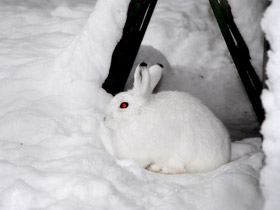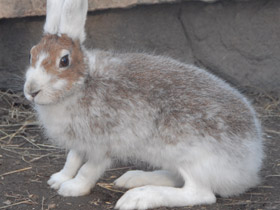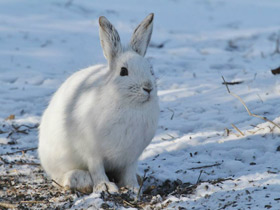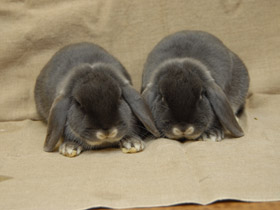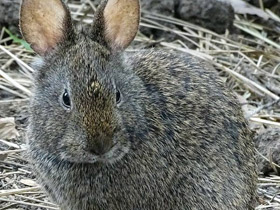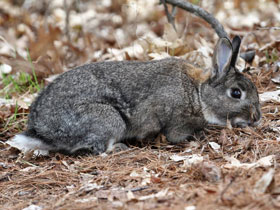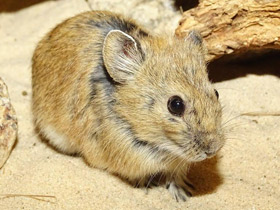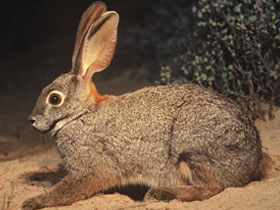Los lagomorfos (Lagomorpha)
Lagomorphs (Lagomorpha, from the Greek lagōs, λαγώς, hare and morphē, μορφή, form) are an order belonging to the placental mammals, which includes rabbits, hares and pikes. Until the early 20th century they had been regarded as rodents but there are considerable differences to dissociate the two orders. There are 110 recent species of lagomorphs of which 109 are still extant, including 34 species of pika, 42 species of rabbit and 33 species of hare.
Distinctive features of Hares
Until recently, these animals were classified as rodents, along with squirrels, rats and beavers. However, later zoologists discovered that only they have two pairs of incisors and a completely different structure of the stomach than in rodents. In hares it resembles the stomach of ruminants, and the process of digestion occurs in much the same way as in sheep and cows. There is another strange peculiarity of this group of animals with the scientific name "cectrophy", which allows them to make fuller use of coarse and low-calorie vegetable fodder. During the day, hares excrete faeces in the form of soft, mucus-covered balls - this is semi-digested food with the addition of bacterial intestinal microflora. By eating these "concentrates", the animals obtain vital elements. Their evening (or "final" faeces) are dry and hard.
The order Lagomorpha is small. It includes only 60 species of animals from two families, however, they are distributed on all continents except Australia (but even there very successfully acclimatised).
Representatives of the Hare family
It includes 45 species of hares and rabbits of rather similar appearance: they have long ears, a short tail, and the hind legs are much longer than the front ones. They inhabit all natural zones from tundra to equatorial forests and climb mountains up to 5000 metres. Hares are more agile and some of them can reach speeds of up to 70, rabbits run worse (no more than 20 km/hour) and live in burrows. It is interesting that among hares there are species that are excellent swimmers and lead a semi-aquatic lifestyle. The climbing hare, an endemic of Ryukyu Island, is able to climb trees, clinging to the bark with its long and sharp claws, and often sleeps in hollow trees. However, this is exotic, and most hares live on the ground, including the Belyak and Rusak, which are widespread in Russia. Both species have a patronising colouration, and after the autumn moult their coat turns white and becomes invisible in the snow. The long-legged rusak is a steppe animal by its origin; it entered the forest zone only after the open landscapes created by man - fields, pastures, wastelands. The shorter-legged squirrel is an original inhabitant of forests.
Lifestyle and habits
Hares have excellent eyesight. Their eyes are squinted and located on the sides of the head, providing an unusually wide field of vision (almost 360 degrees). During the mating season, hares gather in groups of up to several dozen individuals. Often males fight viciously, standing on their hind legs and striking with their forelegs. Hares have a lot of enemies; they are hunted by birds of prey (golden eagle, goshawk, owl, white owl) and animals (lynx, fox, wolf). True, the hare is not called cunning for nothing - it has many different ways of defence. For example, it is known how the hare, running away, confuses the tracks: having run some distance ahead, he can return on his tracks or make a huge jump to the side. Then the predator has to sort out for a long time in which direction he ran: forwards or backwards? Another trick is a weak skin and weak coat. If a predator grabs a hare by the skin, it can easily escape, leaving the pursuer only a piece of fur.
Social behaviour
But perhaps the hare tribe would not have been able to resist its numerous enemies and would have disappeared from the face of the earth if it had not been for its high fecundity. The russak in the southern regions has up to four litters a year, with each litter containing up to 8 hares. The northern squirrel, of course, is not so prolific, but it also has 2-3 litters of 2-5 hares. Hares are born well-developed, with open eyes. But their mothers behave rather unusually: they leave their babies somewhere under bushes and run away. However, this behaviour has its own explanation. Newborn hares do not emit any odour, because the odour and sweat glands of hares are located only on the soles, and the hare, if it sits still, and even tucked up its legs, will not smell any predator. A hare calf visits the baby as rarely as possible in order not to "give" it away. Her milk is very fatty and nutritious, so 2-3 feedings are enough for a baby hare for a whole day. In addition, rabbits feed not only their own babies, but also other people's babies, and after 2 weeks, they can't afford anything - they switch to plant food.
How rabbits differ from hares
Hares do not have permanent shelters and live alone. Rabbits, on the other hand, usually settle in colonies and dig deep, complex labyrinthine burrows. Rabbits are born in a relatively safe burrow, so they are blind, naked and absolutely helpless. Only after 8-9 days the babies begin to see and hear. Rabbits in general are inferior to hares both in acuity of hearing and vision, and in speed of running. The homeland of the wild European rabbit is considered to be the Iberian Peninsula and North Africa. Since antiquity, people have dispersed them throughout much of Europe for hunting fun. Only severe snowy winters restricted its spread. But where there are no restraining factors, the number of rabbits can reach a catastrophic value. This is exactly what happened in Australia, where the first wild rabbits were brought in 1859 on board the steamer "Lightning". The conditions here were so favourable for them that rabbits began to bring not 20, as in Europe, but 40 rabbits a year. By the end of the century there were already billions of rabbits in Australia, and their invasion took on the character of a natural disaster. Eventually man was forced to use bacteriological weapons against them - they began to infect them with the disease myxomatosis. At first, this brought very tangible results: the number of rabbits was reduced by 10 times. However, they soon developed immunity to the disease, and the problem has not been completely solved to this day.
When rabbits were domesticated
Wild hares and rabbits are hunted by humans everywhere for their meat and fur, and rabbits were domesticated in ancient China in the 6th century BC. Currently, there are more than 50 breeds of domestic rabbits, differing in size, colour, coat length and other features. They give people dietary meat, pelts, delicate down, and are also decorative and laboratory animals. Meat rabbits (for example, white giant) weigh almost 10 kg, and the length of the coat of the famous Angora rabbit reaches 12 cm, and each rabbit gives up to 500 g of down.

















